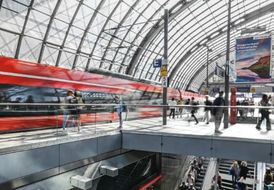Markets and strategy
The central objective for DB Long-Distance is to double the number of passengers to 260 million per year compared with 2015. According to forecasts, the long-distance transport market will continue on its growth path in the aftermath of the Covid-19 pandemic. In order to achieve the climate policy targets and against the backdrop of increasing environmental awareness, DB Long-Distance intends to further expand its rail market share through attractive offers despite increasing competition. The proportion of the population living in urban metropolitan areas in Germany will have increased by 2050, making fast and direct connections between major cities ever more important. At the same time, the connection of people in rural regions to long-distance transport must be ensured.
As an integral component of the Strong Rail strategy DB Long-Distance makes an important social contribution in this way. The number of passengers was significantly increased through offers tailored to different target groups, an increase in the number of service staff, a wide range of marketing measures and capacity expansion of the fleet.
In order to achieve the strategic objectives, both the increase and the stabilization of production and the further development of attractive travel services are necessary. Through this, DB Long-Distance contributes significantly to the desired shift of traffic towards rail and to tackling climate change. DB Long-Distance’s core identity – “Our drive: Connecting people, overcoming distances,” “Our mission: The best possible journey – together with passion and excellence,” “Our promise: Arriving by the time of boarding” – continues to be of central importance. By continuing to develop the project portfolio along the strategic areas of the Strong Rail strategy, we have continued to drive the implementation of our strategic targets.
- More robust: In order to meet increasing demand, DB Long-Distance is expanding its vehicle fleet and maintenance capacity, and thus invested in the expansion of the fleet in 2022. The maintenance capacities required for this growth will be ensured, among other things, by expanding the existing depots in Hamburg and Berlin and by opening new depots in Dortmund. With about 1,000 new service employees, DB Long-Distance is once again improving its personal service. Recruiting, qualification and retention of employees have an important part to play in this significant expansion and in compensating for fluctuations and age-related departures. Recruiting is particularly focused on the rapid and qualified occupation of positions critical to operations and services, such as multiple unit drivers and train attendants. DB Long-Distance is also working continuously on increasing employee satisfaction, for example by improving work-life balance using innovative IT tools that give greater consideration to employees’ wishes during staff scheduling.
- More efficient: Improved processes are intended to provide all long-distance trains with high-quality equipment and competitive costs. To increase vehicle availability and quality, production will be digitalized and optimized further. For example, in 2022, the digital workplace on-board service was introduced for train attendants. The new system reduces the number of terminals required for the on-board service and lays the foundation for leaner, digital processes on board trains in the future.
- More modern: DB Long-Distance aims to build a flexible, reliable and high-frequency long-distance transport network in line with Germany in sync (Deutschland-Takt). By strengthening the metropolitan network and increasing the number of connections between the regions, the target is to enable 80% of the population in Germany to have direct access to long-distance transport. DB Long-Distance is creating attractive and competitive offers by expanding its lines, increasing frequencies and shortening travel times. For example, Chemnitz was connected to the long-distance transport network again in 2022. With the opening of the high-speed line between Wendlingen and Ulm in December 2022, travel time between Stuttgart and Munich was reduced by about 15 minutes and the daily service between the two cities increased by about 20 to 90 journeys. Digital customer channels support passengers on their journeys. As a digital platform, DB Navigator provides access to the system and facilitates modern and timely travel support along the entire travel chain. Since autumn 2022, the next generation of DB Navigator has been used as a test version. The host concept strengthens the personal service component, which is part of a competitive travel experience. In addition, the new BahnBonus incentive program lowers the threshold for status benefits and creates more incentives to opt for the climate-friendly railway more frequently. The range of services is rounded off by modern DB Lounges, which make it easier for passengers to feel comfortable at stations.
-
Greener: Environmental protection is a matter of course for DB Long-Distance as a pioneer of green mobility in Germany. Since 2018, the trains have been using 100% eco-power. On lines where fuel remains necessary, we will be switching completely to sustainable biofuel by 2025. All new maintenance facilities are also climate-neutral. There are also further measures to achieve greater sustainability to complement these activities.


